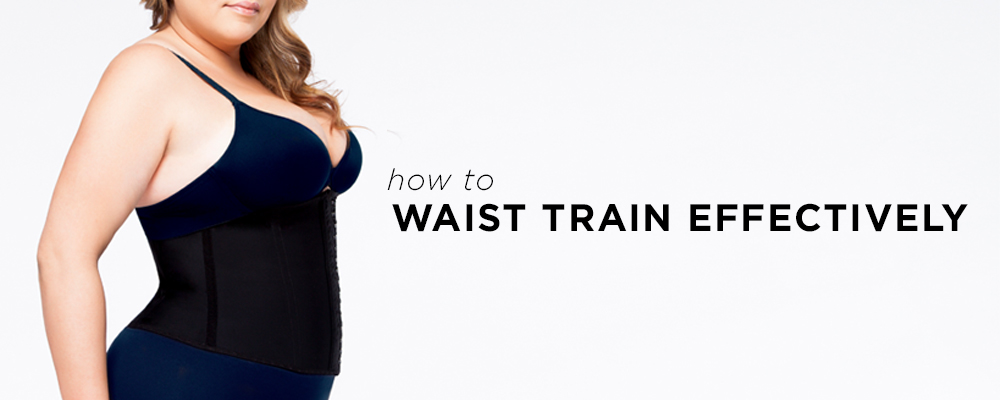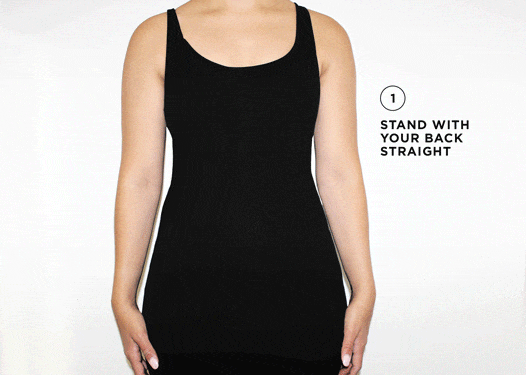How To Waist Train Effectively
Posted by by hourglass angel on Apr 1st 2017
When you’re new to waist training, a very common question you might be wondering is: how to waist train effectively?
It’s a great question because there are so many factors that go into a successful waist training experience. We thought it would be helpful to round up some best practices and answers to your frequently asked questions, so that you’ll be fully equipped as you start your personal waist training journey.
When it comes down to it there are three basic components to effective waist training: choosing the right waist trainer, using waist training as a part of a healthy lifestyle, and making waist training a daily habit.
- Choosing the Right Waist Trainer
It all starts with the right tools. In order to get the best waist training results, you need to have a waist trainer that is designed to help you meet your unique personal goals. Here’s how to get started finding the perfect waist trainer.
Determine Your Personal Goals
What do you want to use your waist trainer for?
Are you using it exclusively for workouts, or do you want to use it as part of an all-day, everyday regimen (which we highly recommend)? Are you trying to lose inches from your waistline or are you primarily just trying to firm up your midsection? These factors can all go into the decision of what style of waist trainer is right for you.
Identify The Features You want
We have many options when it comes to the style and function of our waist trainers. Here are some of the features you may or may not prefer based on your preferences and needs:
Steel-boned lace-up corset vs. latex cincher: corsets will give you the most dramatic waist-slimming results without the smell or feel of latex, while cinchers might be more comfortable and versatile under clothing.
Related: Waist Training 101: Waist Trainers vs. Corsets (What’s the Difference?)
Workout vs. everyday waist trainer: workout waist bands are very durable and you won’t risk damaging them during strenuous exercise; since they are also cut shorter, they can give you more range of motion. Everyday cinchers and corsets are ideal for all-day wear and provide more coverage, particularly for the back and lower abdomen.
Vest style vs. band style: some women love the extra bust support that vest style waist trainers provide, as well as coverage for the back over the bra line.
Closure options: the biggest difference here is between lace-up corsets and hook-and-eye closure cinchers, which is discussed above. Hook-and-eye closures generally come in two or three rows. You may prefer three rows if you are planning to lose weight, so that you will have more room to size down. A few cinchers also come in a no-closure style for when you need to be especially discreet or zip-up style when you want maximum control.
Sizing: If you are especially tall, short or plus-size, you will want to consider the waist trainers that are designed for your body type, so that they will provide the optimal amount of coverage and compression for your midsection.
Style and color: these are more a matter of preference, but it can be fun to have a colorful or metallic workout band! For everyday use under your clothes, you might also want to have a black or nude colored cincher or corset.
Take Accurate Measurements
The most important measurement when selecting your perfect waist trainer is, of course, your waist. Using a vinyl measuring tape, measure the narrowest part of your waist, which is typically a couple of inches above your belly button, where there is a natural bend in your torso when you lean to one side. Make sure that the tape is level. It should lie flat on your skin or a very thin tank tap, but it shouldn’t be so tight that you can’t slip a finger underneath.
Once you’ve determined your waist measurement, follow the sizing chart for your garment of choice precisely! Every waist trainer on our site has been carefully curated and tested, and we have adjusted the sizing charts to reflect exactly the way they will fit, based on your measurements. Don’t simply go with your dress size. Also, note that corset number sizes do not correspond exactly with your waist size; instead, they represent what your waist measurement will be while the corset is tightened.
Try on Your Waist Trainer
Once you receive your waist trainer in the mail, try it on carefully to ensure that you in fact have the ideal size and style. It can be tricky to try on, so follow the instructions carefully. Whatever you do, do no pull or yank on the garment, as you will risk damage and will not be able to return or exchange it. While a waist trainer should be tight, if it fits properly you will not need to force it.
Hook-and-eye closure cincher: when trying on this style of garment for the first time, it is easiest to start at the bottom and work your way up. Using the loosest row of hooks, begin by clasping the bottom hook while holding it at the narrowest part of your waist. As you move your way up the row, pull the garment down. By the time it is fastened, it should fit snuggly over your whole abdomen and provide an immediately flattering look.
Lace-up corset: Fastening a corset is quite different than trying on a cincher. To start, make sure the steel busks are in the front; step into your corset. Ideally you should use a mirror or ask another person to assist you with tightening. The laces in back make an “X” pattern, similar to shoelaces. You will be working your way from the top and bottom of the laces towards the middle. Carefully tighten one row at a time. The first time you try on your corset, do not fasten it as tight as it will go. Instead tie off the laces when it is snug but not constricting you. You should still be able to tell how well it fits based on the coverage it provides around your midsection. Even when not fastened tightly, it will still give you an immediately flattering hourglass shape.
Once you’ve found the perfect waist trainer and confirmed that it fits, it’s time to incorporate waist training into your lifestyle! And don’t worry if you can’t pick just one. We actually highly recommend that you have at least two waist trainers to rotate through your wardrobe!
- How to Waist Train as Part of a Healthy Lifestyle
This is the fun part: incorporating waist training into your healthy lifestyle, to get you the long-term results you want! To ensure effective waist training, make sure you follow these tips:
Break in Your Waist Trainer
Before your start wearing your waist trainer all day every day, it is going to take an adjustment period. What’s more, your garment needs to be broken in, just like a pair of shoes. If you plan on wearing your waist trainer at a special event, be sure you give yourself adequate time to prepare.
Latex cinchers: after you try yours on for the first time, only keep it on for about an hour the first day. You can slowly increase the amount of time you wear it each day by half an hour to an hour. Read more below about how to daily regimen into your lifestyle.
Steel-boned corsets: it is very important to go through a process called “seasoning” your corset so that the material and steel boning can mold to your body’s shape. As with the latex cincher, start by wearing the corset for about an hour or even less on the first day, and only loosely tied. You can gradually add a little more time each day and even tighten it a little bit each time. It should be snug but not tight for the first two weeks. After fourteen days of up to six hours a day, you can pull the laces tight and start wearing it longer. By the time it is seasoned, it should really hug your figure without any gaps, and the laces should glide easily through the holes.
Introduce a Waist Training Regimen Gradually
It’s convenient that waist trainers need to break in because so do you! Chances are you are accustomed to sitting and standing with a slouch, so holding your back and core straight for long hours along with tight compression can feel a bit awkward at first. Add a little bit of time each day for the first three to four weeks of waist training. You may prefer to break it up into two small sessions a day instead of one long one. Your goal should be to wear a waist trainer for at least eight and up to twelve hours a day for the best results.
Exercise Regularly
We can’t emphasize this enough: a waist trainer is just one piece of an effective slim-down plan. You also need to try to work out regularly—ideally four to five days a week. We especially recommend doing strength-training exercises to boost your metabolism and strengthen your core. We have many workout suggestions, all of which are ideal for use with a workout band.
Related: Waist Training Exercises To Try At Home
Eat Smart
You’ll be sabotaging yourself if you work so hard to keep your midsection slim with waist training but then harm your body from the inside out!
Maintain a diet rich in healthy whole foods. While occasional cleanses can be helpful to jumpstart eating right, we actually don’t recommend that you “go on a diet” in which you starve yourself; in the long term this is not a sustainable technique and your weight will only bounce back. Instead, avoid sugar and processed foods as much as possible and eat only when you’re hungry. The waist trainer can help you with portion control and will encourage you to eat several small meals a day instead of three big ones.
- Making Waist Training a Daily Habit That Lasts
Starting a waist training plan is one thing; keeping up with a waist training plan is another. In order to make waist training most effective, you have to stick with it for the long haul! The key is to make it a habit that is easy and natural to keep up. You get dressed every day, right? Your waist trainer should just be a part of that routine. Here are some tips that can help.
Just Do It: over and over again our customers have told us that the thing that motivates them to keep waist training is seeing results. If you do it every day for a month, you will start to notice its effects, and you will want to keep it up. Your friends and family will notice too, giving you that boost in confidence that works to motivate you!
Track Your Progress: Take measurements and photos of yourself at least once a month and preferably more, so you can see just how much you’ve been able to slim down! That will get you excited to keep up the good work.
Find a Buddy: Waist training is better together! Do it with a friend and hold each other accountable. This can be especially fun if you are slimming down for a special event together.
Make Easy Reminders: Do little things in your everyday routine that will remind and encourage you to put on your waist trainer like writing notes for yourself on your mirror or laying out your outfits the night before. You’re much less likely to fail if you’re setting yourself up for success in advance!
Try, Try Again: If you get out of the habit, remember that it is very easy to start it up again. All it takes is a little decision. Don’t give up!
Related: How To Make Waist Training a Habit
We hope that most of your questions are answered about how to waist train effectively and that you’re motivated to get started!







